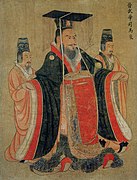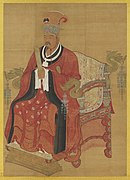Bixi (clothing)
| Bixi | |||||||
|---|---|---|---|---|---|---|---|
 Illustration of a bixi found in the Chinese encyclopedia Gujin Tushu Jicheng, section "Ceremonial Usages", between 1700 and 1725 AD. | |||||||
| Chinese name | |||||||
| Chinese | 蔽膝 | ||||||
| Literal meaning | Knee cover | ||||||
| |||||||
| Alternative Chinese name | |||||||
| Chinese | 韍 | ||||||
| |||||||
| Korean name | |||||||
| Hangul | 폐슬 | ||||||
| Hanja | 蔽膝 | ||||||
| |||||||
Bixi (Chinese: 蔽膝; pinyin: bìxī; lit. 'Cover knee'; Korean: 폐슬; Hanja: 蔽膝; RR: Pyeseul), also known as fu (Chinese: 韍),[1] is a type of traditional Chinese decorative piece of fabric which acts as a knee covering.[2] It originated from primitive clothing and since then, it continued to be worn and became part of the ceremonial attire.[2] The bixi was worn by both men and women.[3] Bixi originated in China and was later introduced in Korea during Goryeo and Joseon by the Ming dynasty, along with many garments for royalties.[4][5]
History[]
The bixi originated from primitive clothing back when animal hides were used to cover the abdomen and the genitals.[2] During the Shang dynasty, the basic style of clothing for men and women consisted of yichang and bixi.[6] Among many other types of female clothing items, the bixi was listed in tomb inventories dating from 361 AD.[7] In the Ming dynasty, the bixi became part of the official clothing.[3]

A Standing Dignitary wearing a bixi, Shang dynasty, 12th-11th century BC.
Bixi in set of attire[]
Men's Clothing[]
A red bixi was worn as part of the mianfu which was worn by the Chinese emperors.[2]
A crimson bixi was worn in the tongtianguanfu.[8][9]

Mianfu of Emperor Wu of Jin dynasty, 7th-century painting by court artist Yan Liben

Emperor Wen of Sui, wearing mianfu.

Wanli Emperor wearing a red bixi over his skirt as part of the mianfu set of attire, Ming dynasty.

Illustration of a Ming dynasty style Bixi and dadai worn with the mianfu.

Emperor Xuanzu (宣祖) of Song wearing tongtianguanfu.
Women's clothing[]
A bixi was also worn with the diyi worn by Chinese empresses; the bixi worn in the diyi hanged in front of the garment and had the same colour as the bottom colour as the lower skirt.[10]

Song dynasty empress wearing diyi.
Gallery[]
See also[]
- Hanfu
- List of Hanfu
- Mianfu
References[]
- ^ Zhang, Fa (2016). History and spirit of chinese art. Honolulu. p. 13. ISBN 978-1-62320-130-2. OCLC 933763535.
- ^ a b c d Hua, Mei (2011). Chinese clothing (Updated ed.). Cambridge, United Kingdom. p. 56. ISBN 0-521-18689-7. OCLC 781020660.
- ^ a b Zhongguo xie zhen hua. Shanming Guan, 關善明 (Di 1 ban ed.). Xianggang: Mu wen tang mei shu chu ban she you xian gong si. 2003. p. 38. ISBN 988-97206-2-0. OCLC 56424659.
{{cite book}}: CS1 maint: others (link) - ^ "폐슬(蔽膝) - 한국민족문화대백과사전". encykorea.aks.ac.kr. Retrieved 2021-12-28.
- ^ "폐슬(蔽膝)". Encyclopedia of Korean Folk Culture. Archived from the original on 2019-06-16.
- ^ Lüsted, Marcia Amidon (2016). Ancient Chinese daily life (First ed.). New York. p. 22. ISBN 978-1-4777-8889-9. OCLC 957525459.
- ^ Dien, Albert E. (2007). Six dynasties civilization. New Haven, Conn.: Yale University Press. p. 324. ISBN 978-0-300-07404-8. OCLC 72868060.
- ^ 5000 years of Chinese costumes. Xun Zhou, Chunming Gao, 周汛, Shanghai Shi xi qu xue xiao. Zhongguo fu zhuang shi yan jiu zu. San Francisco, CA: China Books & Periodicals. 1987. pp. 108–109. ISBN 0-8351-1822-3. OCLC 19814728.
{{cite book}}: CS1 maint: others (link) - ^ "宋代皇帝服饰:通天冠服 - 栖凤阁汉服网|最美中国风 尽在栖凤阁 Powered by Hishop". hanfudian.com. Retrieved 2021-12-22.
- ^ Zhang, Shuhua; Shanat, Musdi bin Hj; Abdullah, Qistina Donna Lee (2021-03-31). "The Expression of Religious Elements and Factors of Religious Thoughts in the Empress's Ceremonial Costume "Hui Yi" of Song Dynasty". International Journal of Service Management and Sustainability. 6 (1): 89–108. doi:10.24191/ijsms.v6i1.12880. ISSN 2550-1569.
- Chinese traditional clothing
- Clothing stubs
- China stubs











